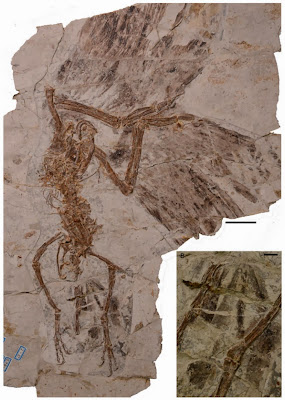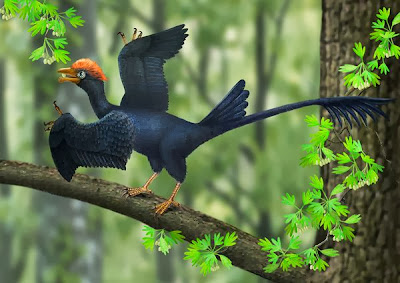 |
| A modern bird-style tail has been found in the early bird Jeholornis, seen in detail in the inset [Credit: O’Connor et al/Chinese Academy of Sciences[ |
It had been thought that Jeholornis only had feathers at the tip of its tail, spread out like a palm frond and largely useless for flight. This is similar to the tail feathers of tailed dinosaurs, such as the flightless dinosaur Caudipteryx and the four-winged dino-bird Microraptor.
In contrast, modern birds, which evolved from dinosaurs, have much shorter stubs of tails called pygostyles, formed by fusing several vertebrae. These have feathers attached to them, which most birds use for flight and some, like the peacock, use for display.
The find makes Jeholornis unique, as it combines an ancestral long tail with a fan of feathers at its base that resembles the tail feathers of modern birds, says Zhonghe Zhou of the Institute of Vertebrate Palaeontology and Palaeoanthropology in Beijing. "We did not expect to find this new structure," he told New Scientist.
Drag reduction
Zhou's group examined 11 Jeholornis fossils with preserved tail feathers and found that four had both aerofoil-like fans up to 10 centimeters long at the base of their tail and frond-like tufts of feathers at the tips. A further four just had the aerofoils, and two had just the frond-like tufts, while one had traces of feathers that could not be identified.
 |
| A reconstruction of a two-tailed 120-million-year-old Jeholornis [Credit: Aijuan Shi] |
The resemblance of the fan to the tails of modern birds suggests "it would be a reasonably good pitch and roll generator" in flight, says Michael Habib of the University of Southern California in Los Angeles, who was not involved in the study. But he doubts it could have done much for yaw – motion about the vertical axis. However, Stephen Gatesy of Brown University in Providence, Rhode Island, warns that we need to know how the feathers were attached to the body before we can tell how well they aided flight.
With only a handful of long-tailed dino-birds known, the find leaves the place of Jeholornis in the avian family tree unclear. "This could be an intermediate form or an 'evolutionary experiment', which left no descendants," says Habib.

No comments:
Post a Comment